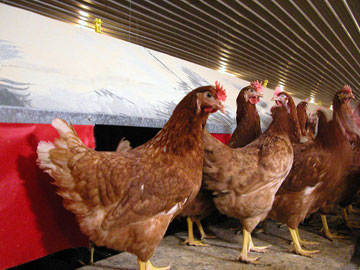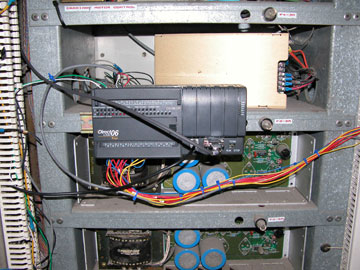In the New England town of Monroe, New Hampshire, you’ll find picturesque settings filled with family-owned dairy and poultry farms. Situated in the Connecticut River valley at the edge of the White Mountain National Forest is a poultry farm, called Pete and Gerry’s Organics, with something to crow about. Pete and Gerry’s Organics has found a way to increase efficiency and productivity by using automation to help gather and process eggs.
Pete and Gerry’s Organics History
 It all started around 1950, when Les Ward, a retired World War II dive bomber, decided to set up a poultry farm using just a few hundred hens. In the late 1960’s his brother-in-law, Rodney Stanton, joined him to manage production for the New England area. The business focus was on quality and freshness.
It all started around 1950, when Les Ward, a retired World War II dive bomber, decided to set up a poultry farm using just a few hundred hens. In the late 1960’s his brother-in-law, Rodney Stanton, joined him to manage production for the New England area. The business focus was on quality and freshness.
In 1997, the business was passed down to Rodney’s son, Pete Stanton, and Les’ son-in-law, Gerry Laflamme.
Continuing the tradition of quality and freshness, Pete and Gerry developed high standards of their own. They wanted totally organic eggs, free from antibiotics, medication, hormones, pesticides, or animal byproducts, to be distributed throughout New England.
Pete and Gerry’s Today
Today, after four generations, this small family farm boasts six barns, each over 400 feet long, and nearly 110,000 Hy-line Brown cage-free hens. The hens are a hybrid cross between a Rhode Island Red and a White Leghorn. Each hen is capable of laying up to 320 eggs per year.
A cage-free environment allows the hens to roam freely inside the barn. When they are ready to lay their eggs, the hens climb into red nesting boxes, which tilt back slightly. As each egg is layed, it gently rolls out of the nest and travels on a series of conveyor belts that transport it to the processing facility.
Originally, workers had to start and stop the conveyors manually to control the egg flow. Flow management was difficult, and the process labor intensive; only one barn could be completed at a time. With an average egg production of 80,000-90,000 eggs per day, Pete and Gerry were looking for a way to increase efficiency and minimize human error.
Automation and Eggs
Gerry’s son, Jesse Laflamme, joined the family business after graduating from Bates College and serves as co-owner and general operations manager. In efforts to increase both efficiency and productivity, Jesse decided to fully automate the barns and processing building.
With no formal training in industrial controls, Jesse relied on advice from AutomationDirect’s technical support team and referenced their product manuals to develop a control system for egg collection and transport. Happy with the overall experience, Jesse states, “The tech support is just fantastic. They are a huge help. If I find a problem on our farm that I have a hunch automation equipment can help us with, I just start reading the books, call up tech support, or look through the catalog and see what products are available, and pretty soon I’ve got a solution.”
Using products from AutomationDirect, Jesse configured PLCs, Marathon motors, GS1 inverters and analog diffuse proximity sensors to control the egg flow.


With the new system, once the egg rolls from the nest onto the gathering conveyor, it is transported to a cross conveyor. Here it begins its journey from the barn to the main transport conveyor, which takes the eggs to the processing building. As the eggs load onto the cross conveyor, proximity sensors send a 0-10 volt signal representing egg volume to a DirectLOGIC D0-05DR PLC. An inverter receives a signal from the PLC and adjusts the gathering conveyor’s motor speed as the egg flow increases or decreases.
This has helped increase efficiency, because, according to Jesse, “having this system in all of our barns has allowed us to run all the barns at the same time. Essentially, the barns are controlling their own flow. We’re able to blend all the egg production together, which is a big plus.”
Jesse also equipped the PLC with a D0-01MC memory cartridge that supports a real time clock. Each barn relies on the PLC to advance the gathering conveyors every 15 minutes during less productive periods to prevent the build-up of eggs.
In each barn, where the cross conveyors join with the main transport conveyor, Jesse uses two analog diffuse proximity sensors to send signals to the PLC. The two signals are averaged and a 0-10 volt signal is sent to an inverter to adjust the cross conveyor speed accordingly.
The speed of the main transport conveyor leading from the barns into the processing facility is controlled by a 3/4 hp motor and GS2 inverter receiving commands from a DirectLOGIC D0-06DR PLC .
As the eggs from all six barns enter the processing facility, Jesse enlists the help of the D0-06DR PLC to control an accumulator table fitted with more sensors. Signals from these sensors are sent to the PLC, averaged, and used to control the proper start and stop sequence of the main transport conveyor from the barns.
Within the processing building, equipment output is set based on cases per hour. In the past, the only way to precisely know the production rates was to print out reports and throw in some mathematical calculations during the process. This was very time consuming. Jesse explains, “That’s obviously eating away at your actual cases per hour. Even at the end of the day, there’s no real report that tells you what your actual cases per hour are, and certainly nothing in real time.”
When the machine puts a set number of eggs into a carton, a signal is sent to the PLC. The PLC adds the signals and divides by the case volume. The built-in clock/timer function of the PLC starts when the first eggs are dropped, and continues to run throughout the day. “No matter what happens, unless you manually stop the clock, it’s doing the calculations on how many actual cases per hour you’re running,” he adds. Jesse chose to use an Optimate OP-414 display panel in conjunction with the DL-06DR PLC to display collected data. The display also shows the daily running total and the number of cases per station.
Jesse also uses the DL-06DR PLC with an H0-ECOM Ethernet module for monitoring water consumption. Each barn’s control system is networked via Ethernet, where the PLC reads pulses from water meters on individual water lines. Using DataWorx Ethernet data logging software, the information is captured for display in Microsoft Excel worksheets. With this information, Jesse can chart and compare water consumption, which is very important in monitoring the health of the hens.
With the new system in place, the egg gathering no longer needs to be monitored by a human. Initial estimates show labor savings of $70,000–$80,000 per year. This increase in efficiency, and continued company growth, has given employees opportunities to take on other positions and responsibilities.
Jesse continues to search for ways to improve the egg processing at Pete and Gerry’s Organics. In the future, he plans to incorporate other methods of PLC control for increasing efficiency, such as water temperature control.
To find out more about Pete and Gerry’s Organics, visit: www.peteandgerrys.com.
By TJ Johns,
Senior Editor
Originally Published: Dec. 1, 2007


